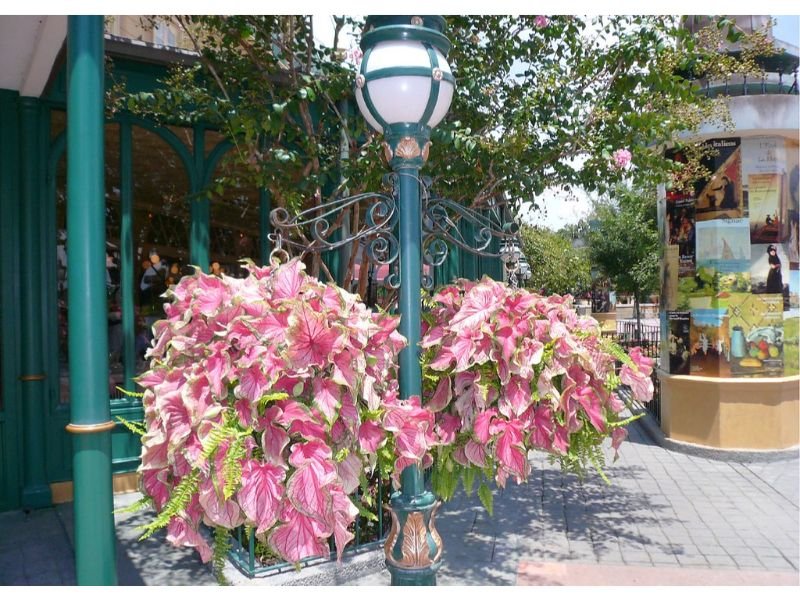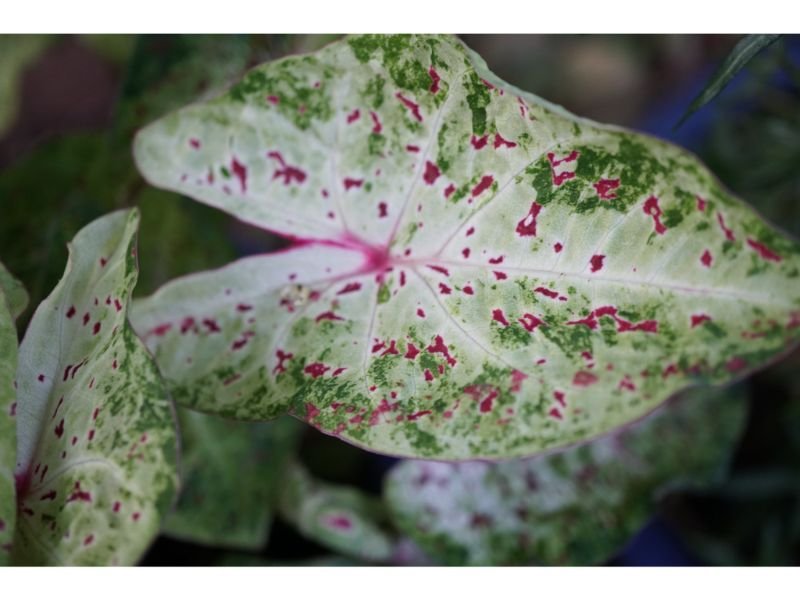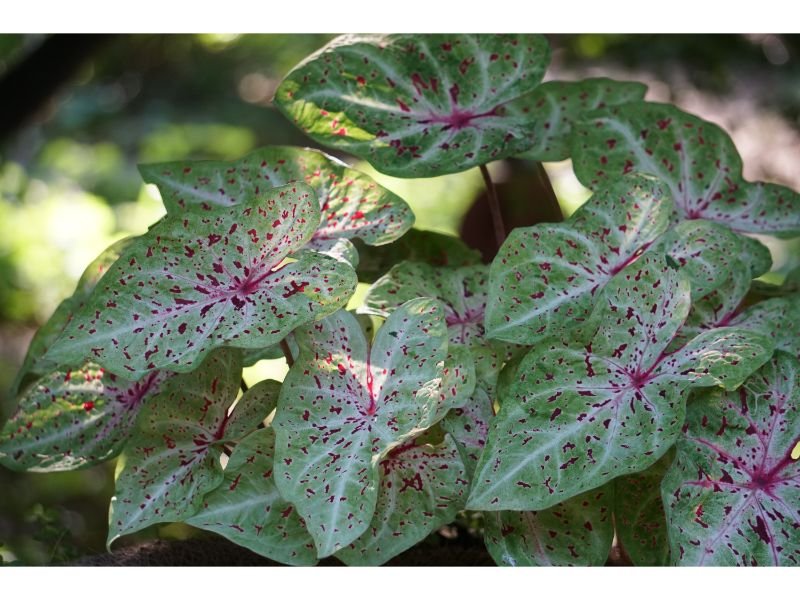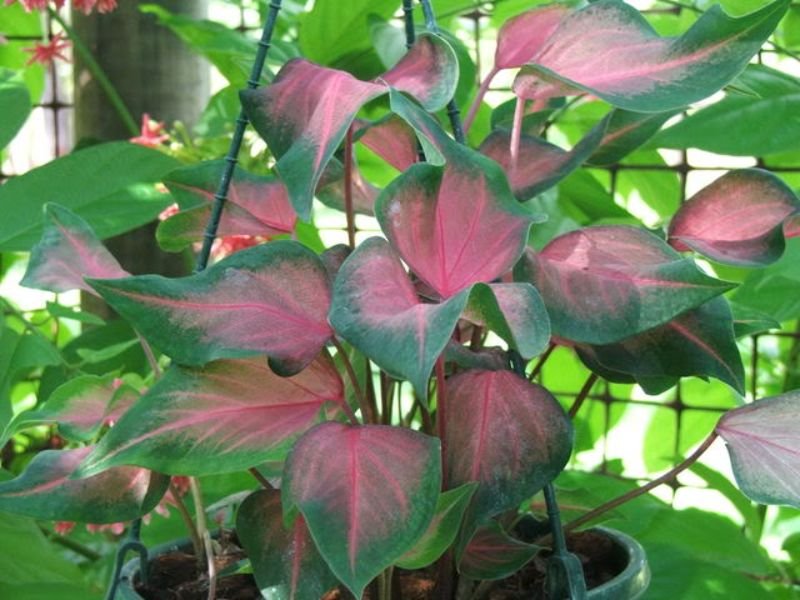Growing caladiums in hanging baskets is an excellent way to showcase their beauty, especially when they are placed in high-traffic areas, such as porches, patios, or balconies. Hanging baskets also allow you to maximize space and add interest to your garden while providing an eye-catching focal point that draws attention and admiration.
However, growing caladiums in hanging baskets requires specific knowledge and skills to ensure their success. This book aims to provide you with all the essential information you need to know to grow and care for caladiums in hanging baskets successfully.

We will discuss the various aspects of growing caladiums in hanging baskets, including selecting the right varieties, choosing the right container, preparing the soil, planting, watering, fertilizing, pruning, propagating, and overwintering caladiums. We will also explore different ways to combine caladiums with other plants and use them in various hanging basket styles to create stunning displays.
Table of Contents
Benefits of Growing Caladiums in Hanging Baskets
Growing caladiums in hanging baskets offer several benefits over other planting methods.
- First and foremost, hanging baskets allow you to make the most of limited space, allowing you to add vertical interest to your garden or indoor space.
- Additionally, hanging baskets can be hung in high-traffic areas, such as porches, patios, or balconies, where their beauty can be easily admired.
- Hanging baskets are also an excellent way to create unique and eye-catching displays. By combining different caladium varieties, as well as other plants, you can create stunning and colorful arrangements that are sure to impress.
- Another advantage of growing caladiums in hanging baskets is that they are less susceptible to pests and diseases. Hanging baskets keep caladiums off the ground, away from common garden pests such as slugs and snails, which can damage their leaves. Additionally, hanging baskets can be easier to monitor and treat for pests and diseases, as they are more visible and accessible.
Choosing the Right Caladium Varieties for Hanging Baskets
When selecting caladium varieties for your hanging basket, it is important to consider a few key factors.
- First, you’ll want to choose varieties that have a compact growth habit, as these will be better suited to the limited space of a hanging basket.
- Additionally, you’ll want to select varieties that have smaller leaves, as larger leaves can be heavy and put additional strain on the basket.
- Another consideration when choosing caladium varieties is their light requirements. While caladiums are shade-tolerant, some varieties prefer more sun than others. If you plan to hang your basket in an area that receives more direct sunlight, such as a south-facing balcony, you may want to select varieties that are more tolerant of sun.
- Lastly, consider the color and pattern of the leaves when selecting caladium varieties. By choosing a variety that complements the colors of other plants in your basket, you can create a visually appealing display that is sure to impress.
Some excellent caladium varieties for hanging baskets include ‘Miss Muffet’, ‘Gingerland’, ‘Frieda Hemple’, and ‘Florida Sweetheart’.
Miss Muffet caladium

The Miss Muffet caladium, a popular ornamental plant belonging to the Araceae family, is known for its distinctive and visually appealing foliage. The plant’s heart-shaped leaves have a burst of colors that range from shades of pink to green, creating intricate and unique patterns.
When grown in a hanging basket, the Miss Muffet caladium can be a stunning addition to any indoor or outdoor space. The plant thrives in well-draining soil and prefers a warm and humid environment. It requires regular watering and should be kept away from direct sunlight to avoid leaf scorching. The Miss Muffet caladium in its hanging basket can add a touch of natural beauty and elegance to any décor, making it a popular choice among gardeners and plant enthusiasts
Gingerland Caladium

The Gingerland caladium, scientifically known as Caladium ‘Gingerland’, is a striking ornamental plant that belongs to the Araceae family. It features large, heart-shaped leaves with intricate vein patterns that come in an array of colors, ranging from green to pink and red.
When grown in a hanging basket, the Gingerland caladium can be an attention-grabbing addition to any indoor or outdoor space. The plant thrives in well-draining soil and requires consistent moisture to maintain its vibrant appearance. In terms of environmental needs, it prefers a warm and humid climate and should be kept away from direct sunlight to prevent leaf scorching.
The Gingerland caladium is an excellent option for gardeners and plant enthusiasts who want to add a touch of natural beauty and sophistication to their home décor. Its stunning foliage and easy-to-maintain nature make it an ideal choice for both novice and experienced plant enthusiasts alike.
Frieda Hemple Caladium

Apart from its visual appeal, the Frieda Hemple caladium is an easy-to-care-for plant, making it suitable for novice gardeners. It thrives in well-draining soil, and its optimal growth temperature range is between 60°F to 75°F. It requires regular watering, and its soil should be kept moist but not waterlogged.
One of the main reasons the Frieda Hemple caladium is excellent for hanging baskets is its size. This plant can grow up to 12 inches tall and 18 inches wide, making it a perfect fit for small hanging baskets. Additionally, the Frieda Hemple caladium can tolerate low light conditions, making it an ideal choice for indoor hanging baskets.
Florida Sweetheart

The Florida Sweetheart caladium is a tropical plant that thrives in warm temperatures between 70°F to 85°F. It prefers well-draining soil, and its soil should be kept moist but not waterlogged. This plant requires moderate to high levels of light, making it an ideal choice for outdoor hanging baskets in areas with partial sun or shaded conditions.
One of the main reasons the Florida Sweetheart caladium is excellent for hanging baskets is its size. This plant can grow up to 18 inches tall and 18 inches wide, making it an ideal fit for larger hanging baskets. Additionally, the Florida Sweetheart caladium is a low-maintenance plant, making it perfect for novice gardeners.
Selecting the Right Hanging Basket for Caladiums

When selecting a hanging basket for your caladiums, there are a few key factors to consider.
- First, you’ll want to choose a basket that is the appropriate size for the number of plants you plan to grow. A basket that is too small may not provide enough space for your caladiums to grow, while a basket that is too large may be difficult to hang and transport.
- Another consideration is the material of the basket. While traditional wire baskets are a popular choice, they can be prone to rust and weathering over time. Alternatively, plastic baskets are lightweight and durable, but may not offer the same aesthetic appeal as a traditional wire basket.
- You’ll also want to consider the shape of the basket when selecting one for your caladiums. While round baskets are a popular choice, they may not provide as much surface area for your plants to grow as rectangular or square baskets. Additionally, flat-bottomed baskets may be easier to plant in and provide a more stable base for your plants.
- Lastly, consider the drainage capabilities of your chosen basket. Caladiums require well-draining soil to prevent root rot, so ensure that your basket has adequate drainage holes or is designed to promote drainage.
Planting Caladiums in Hanging Baskets
To plant caladiums in a hanging basket, you’ll need a few key materials. These include your chosen basket, potting soil, fertilizer, and your selected caladium bulbs.
First, fill your basket with potting soil, leaving enough space at the top for your bulbs. Next, place your caladium bulbs in the soil, with the pointed end facing up. You can plant multiple bulbs in a single basket, but be sure to space them out to prevent overcrowding.
After planting your bulbs, water the basket thoroughly to ensure that the soil is moist. You can also add a slow-release fertilizer to provide your plants with the nutrients they need to thrive.
Finally, hang your basket in a location that receives the appropriate amount of sunlight for your chosen caladium varieties. While caladiums prefer shade, they still require some indirect sunlight to grow and thrive.
Watering and Fertilizing Caladiums in Hanging Baskets
Proper watering and fertilization are key to ensuring that your caladiums thrive in a hanging basket. Caladiums prefer moist, but not waterlogged, soil, so be sure to water your basket regularly to keep the soil from drying out.
When watering your basket, be sure to water deeply, so that the water reaches the roots of your plants. You can also add a layer of mulch to the surface of the soil to help retain moisture.
In terms of fertilization, caladiums benefit from regular applications of a slow-release fertilizer. Apply fertilizer according to the manufacturer’s instructions, and be sure to water your basket thoroughly after fertilizing to help distribute the nutrients evenly.
Pruning and Deadheading Caladiums in Hanging Baskets
Pruning and deadheading your caladiums is an important part of maintaining their health and appearance. As your plants grow, they may produce leaves that become damaged or discolored, as well as flowers that have finished blooming.
To prune damaged or discolored leaves, simply use a pair of sharp scissors or pruning shears to cut them back to the base of the stem. This will help prevent the damaged leaves from affecting the overall health of your plant.
Similarly, if your caladiums produce flowers, it is important to deadhead them once they have finished blooming. To do this, simply use your fingers or a pair of scissors to remove the spent flower, along with its stem, back to the base of the plant. This will encourage your plant to produce new growth and help maintain its overall appearance.
Dealing with Pests and Diseases in Caladiums

While caladiums are relatively resistant to pests and diseases, they can still fall victim to a few common issues. Some pests that may affect your caladiums include spider mites, mealybugs, and scale insects. These pests can be treated with a range of insecticides, but it is important to follow the instructions carefully to avoid harming your plants or the environment.
If you notice signs of disease in your caladiums, such as yellowing leaves, brown spots, or wilting, it is important to take action quickly to prevent the spread of the disease. Some common diseases that can affect caladiums include bacterial leaf spots and root rot. These diseases can be treated with fungicides, but it is important to identify the specific disease and follow the instructions carefully to ensure effective treatment.
In addition to pests and diseases, caladiums can also be affected by environmental factors such as temperature and humidity. Caladiums prefer warm, humid conditions, but they can be sensitive to extreme temperatures or fluctuations in temperature. Keep your hanging basket in a location where it will receive adequate sunlight and protection from strong winds or extreme heat or cold.
Overwintering Caladiums in Hanging Baskets
If you live in a region with cold winters, you may need to take steps to overwinter your caladiums in a hanging basket. To do this, you can either bring your basket indoors and store it in a cool, dry location, or you can move your basket to a sheltered outdoor location, such as a garage or shed.
Before overwintering your caladiums, it is important to prune back any damaged or discolored leaves and remove any spent flowers. You can also apply a fungicide to help prevent the spread of disease during the dormant period.
During the winter months, be sure to monitor your hanging basket regularly and water it sparingly to prevent the soil from becoming too dry or waterlogged. You can also apply a slow-release fertilizer in the spring to help promote new growth as your plants emerge from dormancy.
Propagating Caladiums in Hanging Baskets
If you want to propagate your caladiums to create additional hanging baskets, you can do so by dividing the bulbs. To do this, carefully remove your plant from its hanging basket and gently separate the bulbs, being sure to keep the roots intact.
Once you have separated the bulbs, you can plant them in new hanging baskets filled with fresh potting soil. Be sure to water the baskets thoroughly and provide them with the appropriate amount of sunlight and fertilizer to promote healthy growth.
Creating a Caladium Hanging Basket Display
Caladiums are versatile plants that can be used to create a wide range of hanging basket displays. To create a cohesive display, consider selecting caladium varieties with complementary colors and textures. You can also add other plants, such as ferns or trailing vines, to your hanging basket to add depth and dimension to your display.
When arranging your plants, be sure to consider their growth habits and position them so that they have enough room to grow and thrive without overcrowding. You can also experiment with different basket shapes and sizes to create a unique and eye-catching display.

Gardening is my passion and growing plants indoors has always been a stress relief for me. Grow a banana tree in my apartment once (although failed to produce bananas).






